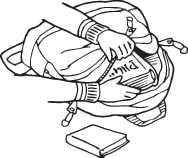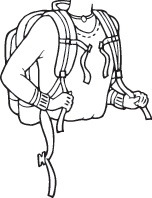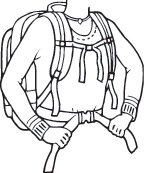|
|
National School Backpack Awareness Day
Backpack Strategies for Parents and Students
Pack It Light, Wear It Right
|
Aching back and shoulders
Weakened muscles
|
Tingling arms
Stooped posture
|
|
Does your child have these symptoms after wearing a heavy school
backpack? Carrying too much weight in a pack or wearing it the
wrong way can lead to pain and strain.
Parents can take steps to help children load and wear
backpacks the right way to avoid health problems.
|
 |

|
*(PDF File - Requires Adobe Reader)
|
|
|
Loading a pack:
- Never let a child carry more than 15% of his or her body
weight. This means a child who weighs 100 pounds
shouldn't wear a loaded school backpack heavier than
15 pounds.
|

|
- Load heaviest items closest to the child's back (the back
of the pack).
- Arrange books and materials so they won't slide around in
the backpack.
- Check what your child carries to school and brings home. Make
sure the items are necessary to the day's activities.
- On days the backpack is too loaded, your child can hand carry
a book or other item.
- If the backpack is too heavy, consider using a book bag on
wheels if your child's school allows it.
|
|
Wearing a pack:
- Both shoulder straps should always be worn. Wearing a pack
slung over one shoulder can cause a child to lean to one side,
curving the spine and causing pain or discomfort.
- Select a pack with well-padded shoulder straps. Shoulders and
necks have many blood vessels and nerves that can cause pain and
tingling in the neck, arms, and hands when too much pressure is
applied.
|
- Adjust the shoulder straps so that the pack fits snugly to the
child's back. A pack that hangs loosely from the back can
pull the child backwards and strain muscles.
- Wear the waist belt if the backpack has one. This helps
distribute the pack's weight more evenly.
|
 |
- The bottom of the pack should rest in the curve of the lower
back. It should never rest more than four inches below the
child's waistline.
- School backpacks come in different sizes for different ages.
Choose the right size pack for your child's back as well as
one with enough room for necessary school items.
|

|
|
|
Need more information?
For more facts on backpack safety, see Backpack Facts: What's all the Flap About?*
To learn more about potential solutions,
see Backpack Strategies for Schools: Help Students Ease the Backpack Burden.*
If you would like to consult an occupational therapist about
an ergonomic evaluation, talk to your child's teacher about
whether a referral to occupational therapy is appropriate. Your
physician, other health professionals, and your school
district's director of special education may also be able to
help.
Occupational therapy practitioners are trained in helping
children with a broad range of issues in addition to ergonomics,
such as good handwriting skills and developmental and behavioral
problems, to help them participate more fully in the
"occupation" of living. Practitioners work with
children in every school district in the nation to improve skills
that will help them perform daily tasks at home, at school, and
at play.
|
|






